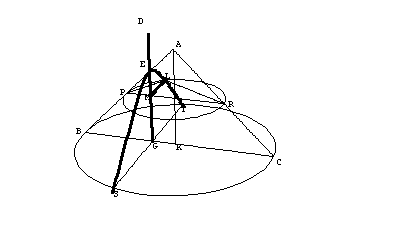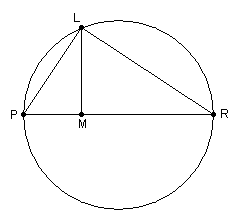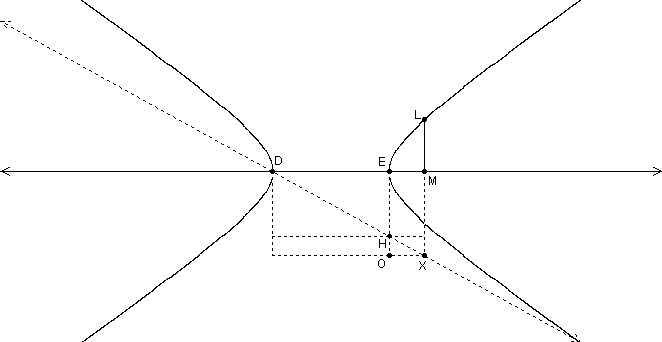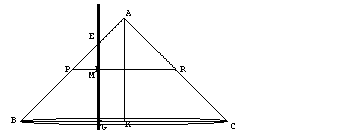- About MAA
- Membership
- MAA Publications
- Periodicals
- Blogs
- MAA Book Series
- MAA Press (an imprint of the AMS)
- MAA Notes
- MAA Reviews
- Mathematical Communication
- Information for Libraries
- Author Resources
- Advertise with MAA
- Meetings
- Competitions
- Programs
- Communities
- MAA Sections
- SIGMAA
- MAA Connect
- Students
- MAA Awards
- Awards Booklets
- Writing Awards
- Teaching Awards
- Service Awards
- Research Awards
- Lecture Awards
- Putnam Competition Individual and Team Winners
- D. E. Shaw Group AMC 8 Awards & Certificates
- Maryam Mirzakhani AMC 10 A Awards & Certificates
- Two Sigma AMC 10 B Awards & Certificates
- Jane Street AMC 12 A Awards & Certificates
- Akamai AMC 12 B Awards & Certificates
- High School Teachers
- News
You are here
Can You Really Derive Conic Formulae from a Cone? - Deriving the Symptom of the Hyperbola
Apollonius, Conics, Book I, Proposition 12
If a cone is cut by a plane through its axis, and also cut by another plane cutting the base of the cone in a straight line perpendicular to the base of the axial triangle, and if the diameter of the section produced meets one side of the axial triangle beyond the vertex of the cone, then any straight line which is drawn from the section to its diameter parallel to the common section of the cutting plane and of the cone's base, will equal in square some area applied to a straight line to which the straight line added along the diameter of the section and subtending the exterior angle of the triangle has a ratio that the square on the straight line drawn from the cone's vertex to the triangle's base parallel to the section's diameter has to the rectangle contained by the sections of the base which this straight line makes when drawn, this area having as breadth the straight line cut off on the diameter beginning from the section's vertex by this straight line from the section to the diameter and exceeding (ύπερβάλλου) by a figure (είδος), similar and similarly situated to the rectangle contained by the straight line subtending the exterior angle of the triangle and by the parameter. And let such a section be called an hyperbola (ύπερβολή).
We will once again consider the cone with vertex A and a plane through the axis intersecting the cone. This plane intersects the cone in the axial triangle ABC, where BC is the diameter of the base circle of the cone. To generate the hyperbola the cutting plane must intersect only one side of the axial triangle but also both "top" and "bottom" of the "double cone." As before this works for all cones in general, but we illustrate here with a right circular cone.
A dynamic view of this construction will be helpful in what follows.
 |
 |
Consider an arbitrary ordinate (i.e. y value) ML constructed on the axis at M. We wish to determine the relationship between ML and EM, that is, the symptom of the conic. The ordinate ML is located in a horizontal plane that cuts the cone in the circle with diameter PR. In this horizontal plane construct the segments PL and LR, which results in a right triangle inscribed in a semicircle. As we saw before in the case of the parabola, by similar triangles this implies
|
|
|
|
|
(1) |
As with the ellipse, Apollonius next constructs a segment EH, perpendicular to DE, such that
|
, |
(2) |

where AK is parallel to ED. [As before, all the lengths DE, AK, BK, and KC are known. He is simply finding the point H that makes the ratio true.]
Notice in the figure that triangles DEH and DMX are similar. This implies that
|
|
(3) |
where the first equality is due to the similarity, and the second one is due to the fact that MX = EO. Next, consider the cone diagram carefully (a different viewpoint is below). The triangles ABK, EBG, and EPM in the axial plane are all similar (parallel lines), and also the triangles ACK, DCG, and DMR are all similar (do you see why?). From these two sets of similar triangles we have
|
|
(4) |
|
and |
 |
|
|
(5) |
Combining (2), (4), and (5) gives us
|
|
(6) |
Now compare (3) and (6) and notice that they imply PM . MR = EM . EO. However, from (1) we have ML2 = PM . MR, so together we have ML2 = EM . EO.
Taking another look at our hyperbola, notice that triangles DEH and XOH are similar. This implies
|
|
|
|
|
|
|
|
(7) |
Here is where the hyperbola derivation changes from that of the ellipse. Notice now that EO = EH + HO, so ML2 = EM . EO becomes, using (7),
|
|
(8) |
From this expression comes Apollonius' use of the word hyperbola for this section. He has proven that the square on ML is equal to a rectangle applied to a line HE with a width equal to EM and exceeding (yperboli) by a rectangle similar to one contained by ED and HE.
Equation (8) is also the form that will enable us to see this as the modern form of a hyperbola. Let y = ML, x = EM, p = HE, and ED = 2a. Substituting into (8) we have
|
|
Can this be written in the standard form of a hyperbola? Again, it is up to you to try it.
With little more than a good grasp of similar triangles, we have derived the equations of the conic sections from the actual slices of cones. Apollonius's contemporaries called him "the Great Geometer" for his work with the conics. If you have made it this far, you at least deserve a hearty congratulations! Now what?
Gary S. Stoudt, "Can You Really Derive Conic Formulae from a Cone? - Deriving the Symptom of the Hyperbola," Convergence (June 2015)

 or
or .
.


 .
. .
.

 .
. .
. .
.


